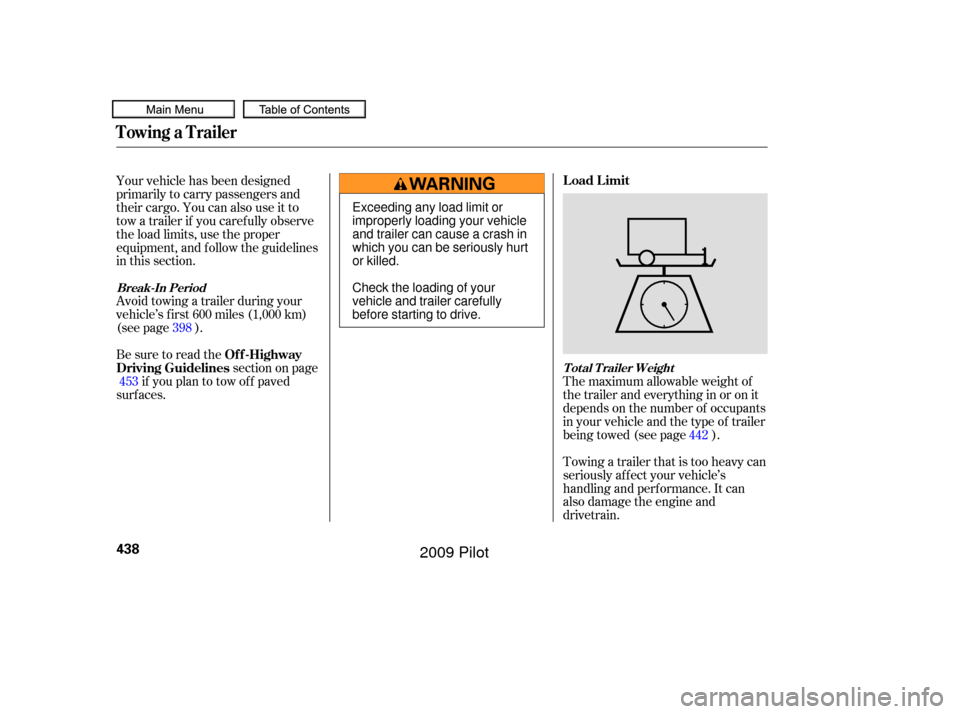Page 417 of 578

This section gives you tips on
starting the engine under various
conditions, and how to operate the
automatic transmission. It also
includes important inf ormation on
parking your vehicle, the braking
system, the VTM-4 system (4WD
models only), the vehicle stability
assist (VSA) system, the tire
pressure monitoring system (TPMS),
and f acts you need if you are
planning to tow a trailer or drive off-
highway.........................
Driving Guidelines .414
........................
Preparing to Drive .414
.......................
Starting the Engine .415
Check Starter System .................................
Message .416
..............
Automatic Transmission . 417
..............................
VTM-4 System .422
...........................................
Parking .423
Tire Pressure Monitoring System ......................................
(TPMS) .424
.............................
Braking System .432
...............
Anti-lock Brakes (ABS) . 433
Vehicle Stability Assist (VSA
),
aka Electronic Stability ........
Control (ESC), System . 435
...........................
Towing a Trailer .438
Of f -Highway Driving ..................................
Guidelines .453
Driving
Driving
413
�����—�����—�
���y�
�������������y���
�(�/���������y�����
���y
2009 Pilot
Page 423 of 578

�µ�µ�µ
CONT INUED
Use this position f or
your normal driving. The
transmission automatically selects a
suitable gear (1 through 5) f or your
speed and acceleration. You may
notice the transmission shif ting up at
higher engine speeds when the
engine is cold. This helps the engine
warm up f aster. To use D , press the
D button when the shif t lever is in
the ‘‘D’’ position. This position is simi-
lartoD,exceptonlythefirstthree
gears are selected instead of all f ive.
Use D when towing a trailer in hilly
terrain, or to provide engine braking
when going down a steep hill. D can
also keep the transmission f rom
cycling between third and f ourth
gears in stop-and-go driving. This position locks
the transmission in second gear. It
does not downshif t to f irst gear
when you come to a stop.
Use second gear: For more power when climbing.
To increase engine braking when
going down steep hills.
For starting out on a slippery
surf ace or in deep snow.
When driving downhill with a
trailer.3
3
3 3
Automatic Transmission
Drive (D) Drive (D ) Second (2)3
Driving
419
�����—�����—�
���y�
�������������y���
�(�/���������y���������y
2009 Pilot
Page 427 of 578

If the vehicle is f acing uphill, turn
the front wheels away from the
curb. Never park over dry leaves, tall
grass, or other f lammable
materials. The hot three way
catalytic converter could cause
these materials to catch on fire.
Always use the parking brake when
you park your vehicle. Make sure
the parking brake is set f irmly, or
your vehicle may roll if it is parked
on an incline.
Set the parking brake bef ore you put
the transmission in Park. This keeps
the vehicle from moving and putting
pressure on the parking mechanism
in the transmission.
If the vehicle is f acing downhill,
turn the front wheels toward the
curb.
Make sure the moonroof (if
equipped) and the windows are
closed.
Place any packages, valuables, etc.
in the cargo area or take them
with you. Turn of f the lights.
Make sure the parking brake is
f ully released bef ore driving away.
Driving with the parking brake
partially set can overheat or
damage the rear brakes.
Check the indicator on the
instrument panel to verif y that the
security system is set.
Lock the doors and the tailgate.
Make sure the glass hatch is
closed securely.
Except LX models
Parking T ips
Parking
Driving
423
�����—�����—�
���y�
�������������y���
�(�/���������y���������y
2009 Pilot
Page 442 of 578

The maximum allowable weight of
the trailer and everything in or on it
depends on the number of occupants
in your vehicle and the type of trailer
being towed (see page ).
Towing a trailer that is too heavy can
seriously af f ect your vehicle’s
handling and perf ormance. It can
also damage the engine and
drivetrain.
Be sure to read the
sectiononpage
if you plan to tow of f paved
surf aces. Your vehicle has been designed
primarily to carry passengers and
their cargo. You can also use it to
tow a trailer if you caref ully observe
the load limits, use the proper
equipment, and f ollow the guidelines
in this section.
Avoid towing a trailer during your
vehicle’s f irst 600 miles (1,000 km)
(see page ).
442
398
453
Towing a Trailer
Load Limit
Off-Highway
Driving Guidelines
T ot al T railer Weight
Break-In Period
438
Exceeding any load limit or
improperly loading your vehicle
and trailer can cause a crash in
which you can be seriously hurt
or killed.
Check the loading of your
vehicle and trailer carefully
beforestartingtodrive.
�����—�����—�
���y�
�������������y���
�(�/���������y���������y
2009 Pilot
Page 443 of 578

�Î �Î
�Î �Î
The weight that the tongue of a f ully
loaded trailer puts on the hitch
shouldbe5to10percentof thetotal
trailer weight f or boat trailers, and 8
to 15 percent of total trailer weight
f or all other trailers. (See pagef or limits f or your towing
situation). Too much tongue load
reduces front-tire traction and
steering control. Too little tongue
load can make the trailer unstable and cause it to sway.
The maximum allowable weight of
the vehicle, all occupants, all
accessories, all cargo, and the
tongue load is:
The maximum allowable weight of
the vehicle, all occupants, all
accessories, all cargo, and the
tongue load must not exceed:
on the f ront axle
on the f ront axle
on the rear axle
2:LXmodels 1:ExceptLXmodels
on the rear axle
442
4WD models: 2WD models: 4WD models:
2WD models:
2 1
Towing a Trailer
Tongue Load
Gross Vehicle Weight Rating
(GVWR): Gross Axle Weight Rating
(GA WR):
Driving
439
5,952 lbs (2,700 kg) 6,096 lbs (2,765 kg)
2,921 lbs (1,325 kg)
3,362 lbs (1,525 kg)
3,251 lbs (1,475 kg)
2,921 lbs (1,325 kg)
3,196 lbs (1,450 kg)
�����—�����—�
���y�
�������������y���
�(�/���������y���������y
2009 Pilot
Page 444 of 578

Thebestwaytoconfirmthatall
loads are within limits is to check
them at a public scale. For public
scales in your area, check your local
phone book, or contact your trailer
dealer or rental agency for
assistance.
To help ensure a saf e drive to a scale,
or if you cannot get to a public scale,
we recommend that you estimate
your total trailer weight and tongue
load as described next.Add the weight of your trailer (as
quoted by the manuf acturer) with
everything in or on the trailer. Then
check the tables on page to
make sure you do not exceed the
limit f or your conditions.
The maximum allowable weight of
the f ully loaded vehicle and trailer
with the proper hitch is:
The GCWR must be reduced 2
percent f or every 1,000 f eet (305
meters) of elevation. 442
4WD models:
2WD models:
Estimating Loads
Gross Combined Weight Rating
(GCWR):To Estimate the Total Trailer Weight
Towing a Trailer
440
9,579 lbs (4,345 kg)
8,466 lbs (3,840 kg)
�����—�����—�
���y�
�������������y���
�(�/���������y���������y
2009 Pilot
Page 445 of 578

Estimated
tongue load is:
150 lbs (68 kg)
250 lbs (114 kg)
350 lbs (159 kg)
Park the vehicle on level ground.
Measure and record the distance
from the ground to the bottom of
the trailer hitch.
Connect the f ully loaded trailer to
the hitch.
Measure again f rom the ground to
the same spot on the bottom of the
hitch.
Subtract the second measurement
from the first measurement, then
refer to the following table. Estimated
tongue load is:
150 lbs (68 kg)
250 lbs (114 kg)
350 lbs (159 kg)
450 lbs (205 kg)
If thedifferenceismorethan1¾
inch, you have too much load on the
tongue. Redistribute the load or
remove cargo as needed. If the
dif f erence is:
5/8’’
11/4’’
13/4’’ If the
dif f erence is:
5/8’’
11/4’’
13/4’’
21/4’’
If thedifferenceismorethan2¼
inch, you have too much load on the
tongue. Redistribute the load or
remove cargo as needed.
1.
2.
3.
4.
5.
2WD models
4WD models
Towing a Trailer
To Estimate the Tongue Load
Driving
441
�����—�����—�
���y�
�������������y���
�(�/���������y���������y
2009 Pilot
Page 446 of 578

�Î�Î�Î
�Î �Î�Î
�µ�µ
�Î
�Î�Î
T owing is Not Recommended
Number of
Occupants 2
3
4
5
6
7
8 Maximum T otal T railer Weight
Maximum T ongue Load
T owing is Not Recommended
Number of
Occupants 2
3
4
5
6
7
8 Maximum T otal T railer Weight
Maximum T ongue Load
2WD models
4WD models
Towing a Trailer
442
Total Trailer Weight and Tongue Load Limits:
3,500 lbs (1,588 kg)
3,300 lbs (1,497 kg)
3,100 lbs (1,406 kg)
3,000 lbs (1,361 kg)
2,800 lbs (1,270 kg)
2,000 lbs (907 kg) 350 lbs (159 kg)
300 lbs (136 kg)
230 lbs (104 kg)
200 lbs (91 kg)
150 lbs (68 kg)
100 lbs (45 kg)
4,500 lbs (2,041 kg)
4,300 lbs (1,950 kg)
4,100 lbs (1,860 kg)
4,000 lbs (1,814 kg)
3,800 lbs (1,724 kg)
2,000 lbs (907 kg) 450 lbs (204 kg)
400 lbs (181 kg)
330 lbs (150 kg)
270 lbs (122 kg)
190 lbs (86 kg)
100 lbs (45 kg)
The corresponding weight limits assume occupants fill seats from the front of the vehicle to the back, each occupant weighs 150 lbs (68
kg), and each has 15 lbs (7 kg) of cargo in the cargo area. Any additional weight, including cargo or accessories, reduces the maximum
trailer weight and maximum tongue load. Never exceed the gross axle weight ratings (see page ).
Recommended tongue load should be 5 10% of the total trailer weight for boat trailers, and 8 15% of the total trailer weight for all other
trailers. 439
�����—�����—�
���y�
���������
���y���
�(�/���������y���������y
2009 Pilot